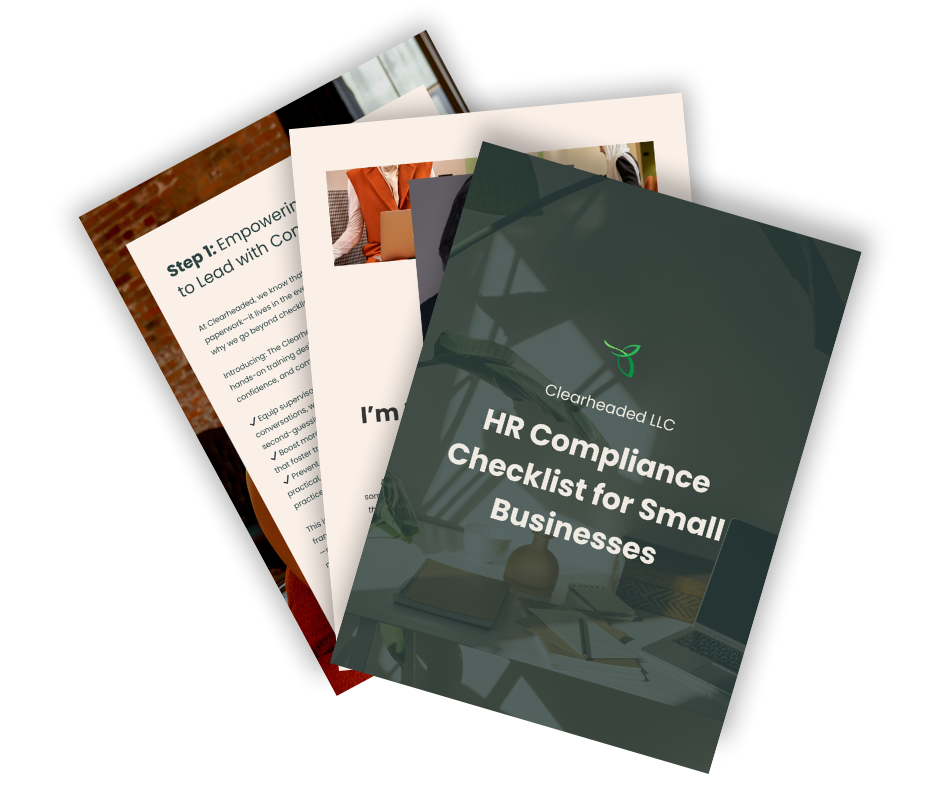The Employee Handbook I Recommend for Small Businesses (And What Most Templates Miss)
You started a business, not an HR department
You didn’t launch your business so you could spend hours Googling what a compliant time-off policy should include or whether you're legally allowed to discipline an employee over text. But once you hired your first few team members, you probably realized something: running a business means you also run an HR department—whether you wanted to or not.
Like many small business owners, you might have downloaded a free employee handbook template, filled in a few blanks, and hoped for the best. And while that may have worked when your team was small, as you scale—those quick fixes start to crack.
That’s where this guide comes in.
In case we haven’t met… Hi, I’m Danette, founder of Clearheaded. I help small business owners across Michigan and beyond create safe, compliant, and thriving workplaces—without the HR chaos. If you're ready to take the guesswork out of things like hiring, PTO, or handling workplace issues, you're in the right place.
You can learn more about our
HR consultant services and how we support small businesses with clarity, strategy, and compliance you can trust.

What is an employee handbook? (And why does it matter?)
An employee handbook is a written guide that clearly communicates your company’s rules, expectations, procedures, and benefits to your employees. But more than that, it’s a tool that protects your business. It sets a consistent standard for how decisions are made, ensures legal compliance, and gives employees clear direction.
A strong handbook helps:
- Prevent misunderstandings
- Establish expectations
- Minimize legal risks
- Document compliance with federal and Michigan labor laws
And unlike that free template you downloaded three years ago, a well-built handbook should actually reflect your company’s values, operations, and state-specific requirements.
How do I create an employee handbook for my small business?
Employee handbooks are invaluable tools for employers to convey consistent messages to employees and ensure your business runs smoothly. A well-crafted handbook sets clear standards, includes the required legal notices, and limits employer liability. Here’s how you can get started:
Tip 1: Identify which employment laws apply
Before diving into the handbook review or drafting process, make sure you’re clear on some basic questions:
- How many employees does your company have in total?
If you’re operating in multiple states, how many employees are in each state? This helps you determine which federal, state, and local laws apply to your business. - Is the company unionized or subject to a collective bargaining agreement (CBA)?
If so, the CBA provisions need to be reflected or modified within your handbook to ensure compliance with applicable labor laws. - What industry does your company belong to?
Does your business fall under industry-specific regulations (like health care, education, etc.)? Is it a federal contractor? Be sure to customize your handbook to include these specialized rules, as industry regulations can vary greatly. - Who has the authority to make key decisions regarding personnel?
Identify the decision-makers in your business who have the authority to modify policies, like those related to employment at will. This ensures clarity on who can update the handbook in the future.
Tip 2: Protect the employer’s ability to modify the handbook and define the nature of the employment
The terms in your employee handbook should clearly outline that you, as the employer, have the ability to modify the provisions of the handbook as needed. Here’s what you must include:
Disclaimer: A strong disclaimer will allow for unilateral modifications by the employer and provide clarification of employee-employer rights and obligations. This ensures that both parties understand the
flexibility of the policies and the
legal framework.
At-will employment: This provision should state that either party (you or your employees) can terminate the employment relationship at any time, with or without notice, for any lawful reason. Additionally, this clause protects your company from creating any implied contract with employees, providing further protection from future disputes.

What is the best program to create a handbook?
There’s no "best" platform—what matters is clarity, customization, and compliance. We recommend using tools like Google Docs, Microsoft Word, or PDF templates that allow easy editing and sharing. More important than the format is working with a consultant who understands what needs to go in the handbook based on your business structure, industry, and location.
How many employees does a small business have?
In HR terms, "small business" typically refers to companies with fewer than 50 employees—but the moment you hire even one employee, you’re responsible for labor law compliance. That includes wage laws, anti-discrimination policies, safety regulations, and classification of contractors vs. employees.
If you're managing a team of 5 to 50, you're right in the zone where an employee handbook isn't optional anymore—it's essential.
Small business rules and regulations for employees
Here are just a few of the Michigan and federal compliance areas that need to be addressed in your handbook:
At-will employment disclaimers
- Anti-discrimination and harassment policies (EEOC compliance)
- PTO, sick leave, holidays, and unpaid leave
- Family and Medical Leave Act (FMLA)
- ADA accommodations
- Employee classification and wage guidelines
- Safety policies
Many of these policies are required under federal or state law, while others help reduce confusion and ensure consistency in how you manage your team.
Employee handbook structure example for small businesses
Here’s an outline of what I recommend you include in a small business employee handbook:
Welcome and Company Overview
- Mission, vision, and values
- General culture and what to expect
Employment Basics
- Hiring practices
- Equal employment opportunity statement
- Employee classification
- Compensation and Benefits
- Payroll schedule
- PTO policy
- Holidays and leave
- Health benefits (if applicable)
Workplace Policies
- Attendance and punctuality
- Dress code
- Code of conduct
- Technology and social media use
- Workplace safety and harassment prevention
Performance and Conduct
- Performance reviews
- Disciplinary process
- Conflict resolution
Legal Notices and Disclaimers
- At-will employment statement
- Acknowledgment of receipt
Disclaimer: This list is for informational purposes only. Always consult with a qualified HR professional or attorney to ensure compliance with federal and state laws.

Are employee handbooks required by law?
While employee handbooks are not required by federal law, they are strongly recommended. In Michigan, handbooks are a critical tool for documenting compliance, protecting your business, and setting fair expectations for your employees.
If an issue arises (a termination, a harassment claim, a wage dispute), a handbook shows that you had clear, consistent policies in place—and that your team was informed.
Why most employee handbook templates fall short
Most templates are outdated, written for large corporations, or fail to address your state’s laws. Worse? They don’t reflect how your business actually operates.
They often:
- Miss state-specific PTO, paid leave, or sick time policies
- Use vague language that can create liability
- Include policies irrelevant to small businesses (like 401k plans you don’t offer)
- Skip important sections like social media or remote work policies
At Clearheaded, we customize every handbook to your business model, industry, and growth goals—so you can feel confident that it’s not just compliant, but actually useful.

Employee Handbooks: your guide to clear expectations and legal protection
An employee handbook is more than just a document—it’s your company’s rulebook and information guide for your team. It clearly communicates what's expected, keeps your business compliant with the law, and serves as a protective shield for both you and your employees. Here’s what to keep in mind when creating a strong, legally sound employee handbook:
Key steps to creating a strong handbook:
- Know the Laws:
First, you need to figure out which federal, state, and local employment laws apply to your business. This depends on your number of employees and where your company operates. Don't forget to consider any industry-specific rules or union agreements that may apply to your workforce. - Maintain Flexibility and Define Employment:
Your handbook should state that you have the right to make changes as needed. It's also important to clarify the "at-will employment" provision, meaning that both the employer and employee can end the employment relationship at any time, for any legal reason. - Prioritize Respect and Safety:
Ensure your handbook includes policies against discrimination, harassment, retaliation (for those who report issues), and workplace violence. Also, highlight your commitment to accommodating employees with disabilities, religious beliefs, and pregnancy-related needs (including lactation breaks). Protect employee privacy in accordance with relevant laws. Make sure there's a clear reporting process for employees to express concerns safely. - Outline Pay and Leave:
Explain employee classifications (exempt vs. non-exempt for overtime), your pay procedures, and your policies for paid time off (such as sick leave, vacation, and holidays) as well as other types of leave (like - Family Medical Leave, if applicable).
Set Expectations and Protect Your Business:
Include rules of conduct, disciplinary procedures (making it clear these are guidelines and not strict steps), confidentiality rules, and policies on things like computer use, social media, drug/alcohol testing, and workplace safety.

Ensure Comprehensive Compliance and Protect Your Business
- Stay Compliant with Local Laws:
Be aware of any local laws that may provide additional employee protections, such as anti-discrimination regulations at the city or county level. - Get Signed Confirmation:
Ensure that all employees sign and date an acknowledgment form confirming they’ve received and understand the handbook. This can be a simple receipt, or if needed, a brief employment agreement. - Consider Additional Contract Terms (Optional):
For added protection, you might want to include clauses in a separate acknowledgment form regarding mandatory arbitration, no class-action lawsuits, shorter time limits for filing claims, and specifying which state’s laws will govern the agreement. - Think About Other Helpful Policies (Optional):
You can also consider including policies on things like introductory periods for new hires, an open-door policy for communication, dress codes, attendance, updating personal information, workplace monitoring, conflicts of interest, and flexible work arrangements. - Keep Benefits Separate:
While your handbook should provide an overview of your benefits plans, avoid including detailed information that could change. Instead, direct employees to the official plan documents for the specifics. - Review Regularly:
It’s a good idea to review your handbook annually with legal counsel to ensure it’s up-to-date with the latest laws. A well-written, legally compliant handbook can be a strong defense if any legal issues arise.
Clarity protects your business
If you’re relying on a one-size-fits-all handbook, you might be exposing your business to risks you haven’t even considered. A custom, state-compliant handbook is one of the smartest, most protective investments you can make as a business owner.
Ready to stop second-guessing your policies and finally get compliant? Let’s build a handbook that reflects your values, protects your business, and sets your team up for success.
👉
Learn more about our Clearheaded HR Essentials for Small Businesses
or
book a free consultation to get started today.

Hi, I’m Danette Durón-Willner
Your trusted partner and HR pro, who is also a labor and employment expert.
If it involves hiring, compliance, workplace conflicts, or anything in between, trust me—I’ve seen it, solved it, and made it simpler for business owners like you.




